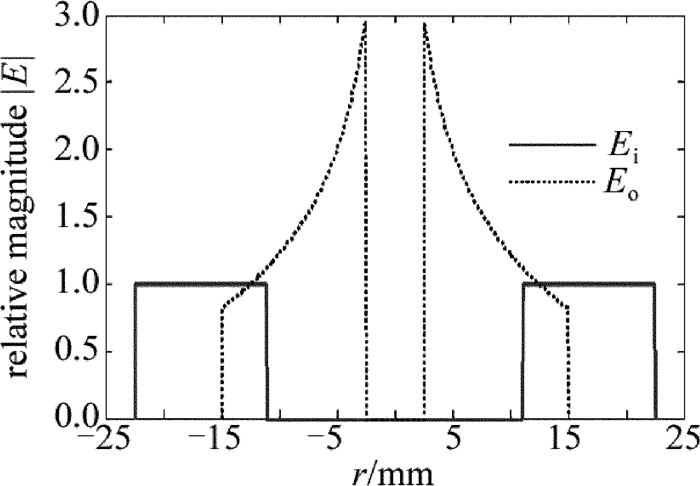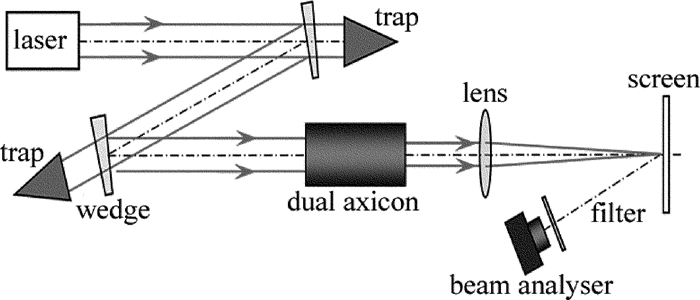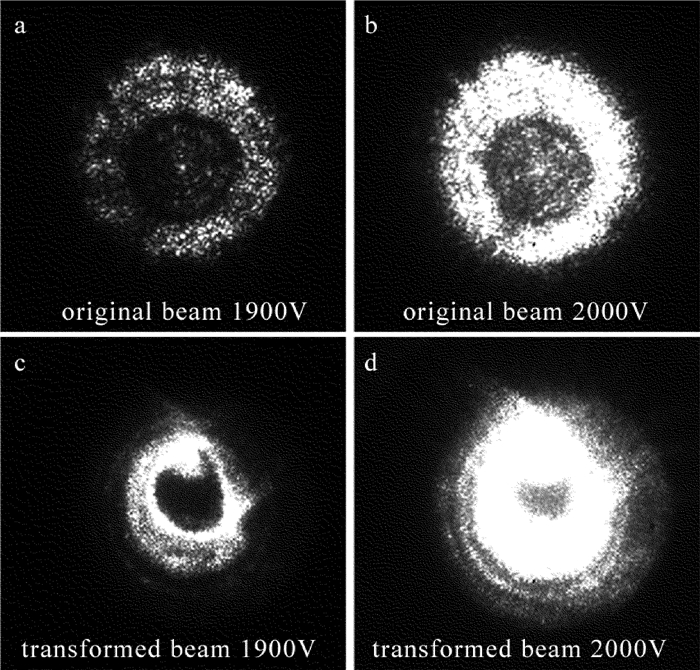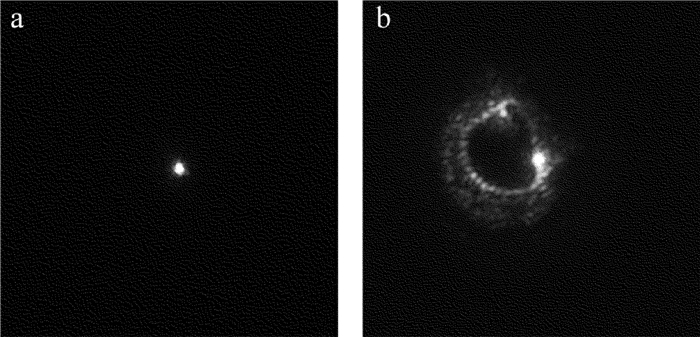Annular laser beam reshaping based on dual axicons
-
摘要: 为了改善非稳腔高能激光系统的光束质量,提高发射光学系统口径的利用率,采用新型的可用于光学非稳腔输出环形光束的光学整形方法,通过在激光腔外的光路上增加光学元件对输出的环形激光束进行了整形变换。在理论分析的基础上,设计并加工了基于双轴锥镜的光束整形装置,针对非稳腔高能激光器输出的环形光束进行了整形实验,取得了与理论分析一致的数据。结果表明,采用双轴锥镜装置整形后的光束比原始光束具有更好的光束质量,光束束腰直径由45mm减小为32mm,光束质量因子M2由14减小到11.8。该方法用于光学非稳腔输出环形光束整形变换具有可行性。Abstract: In order to improvelaser beam quality of unstable cavity high energy laser systems and the utilization of the aperture of a transmitting optical system, a new optical shaping method for the annular beam was proposed. Optical elements were added to the light path outside the laser cavity to shape the output of annular laser beam. On the basis of theoretical analysis, beam shaping devices based on dual axicons were designed and fabricated. The shaping experiments were carried out for the annular beam from an unstable cavity high energy laser. The data was obtained and was consistent with theoretical analysis.The results show that, the beam after shaping by using dual axicons has better beam quality than that of the original beam. Waist diameter decreases from 45mm to 32mm. M2 factor reduces from 14 to 11.8. The method is feasible for the shaping and transformation of the annular beam from an unstable resonator.
-
Keywords:
- laser optics /
- annular beam /
- beam reshaping /
- axicon
-
引言
碳纤维复合材料(carbon fiber reinforced plastic, CFRP)作为一种新型复合材料具有比强度高、低密度和抗疲劳性好等优异的力学性能,被广泛应用在航空航天、医疗设备、军工产品等[1]领域。在CFRP装配过程中,对CFRP进行开槽、钻孔等二次加工是不可避免的。CFRP常规的加工方法有铣削[2]、磨料水射流[3-4]、钻孔[5]、电火花加工[6]等。然而,CFRP具有复杂的各项异性且层间强度低,这些常规的加工方法加工CFRP时易出现材料分层、纤维断裂、毛刺和刀具磨损严重等缺陷[2, 7-8]。
与常规的加工方法相比,激光加工具有无刀具磨损、无接触应力等优点,被广泛用于材料加工。HEJJAJI等人[9]实施了常规钻孔和激光加工玻璃纤维复合材料和CFRP的实验研究,结果表明,激光加工效率更高。YE等人[10]对比了激光打孔和机械钻孔两种加工方式的特点,结果表明,两种加工方式下拉伸性能基本相近,但激光打孔具有更高的表面加工质量。但是激光加工CFRP容易造成较大的热影响区、纤维拔出和纤维末端膨胀等热损伤[11-12]。RIVEIRO等人[13]研究发现,虽然激光加工产生的热损伤是不可避免的,但是可以通过优化工艺参数使热损伤最小化。LEONE等人[14]使用波长1064 nm、平均功率为150 W的Nd∶YAG脉冲激光加工1 mm厚的CFRP板并优化了工艺参数,实验中热影响区(heat-affected zone, HAZ)低至170 μm。与此同时,发现在激光加工过程中增加辅助装置可以有效降低加工产生的热损伤。SOBRI等人[15]研究了辅助气体对激光加工CFRP的影响,结果表明,施加辅助气体有利于降低HAZ。
然而,辅助气体对降低HAZ有限。TANGWARODOMNUKUN等人[16]对比了激光在空气和水中的加工质量,结果表明,水辅助激光加工可以获得更小的热损伤。采用水辅助激光加工时,由于水对激光传输的影响大,不恰当的供液方式容易造成激光能量损失严重,导致加工效率下降[17]。WEE等人[18]在使用薄水层辅助激光加工时发现,当水层厚度超过某个临界值之后,将无法实现材料去除。因此,为了减少水对激光损失的影响,必须减薄流动水层厚度并提高水层流速。GUO等人[19]采用水雾辅助激光加工化学气相沉积金刚石时发现,水雾撞壁形成的流动水层薄且流速快,可以获得较好的加工质量,适用于辅助激光加工[20]。
综上所述,采用水雾辅助激光加工CFRP有望实现低损伤高效率加工的可能。但迄今为止,鲜有使用水雾辅助激光加工CFRP的报道;更重要的是,水雾参数对激光传输的影响尚未被实验研究。本文作者研究了CFRP的水雾辅助激光加工技术,采用光束分析仪和激光功率计研究了水雾对激光传输的影响规律;采用正交实验优化方法,得到了最优工艺参数组合;最后通过回归分析建立了工艺参数和加工质量之间的经验公式。该研究为激光低损伤加工CFRP提供了参考。
1. 材料、设备与方法
1.1 材料
本实验中使用的工件材料是CFRP单向层压板。CFRP厚度为1 mm,由异面正交状态的单层结构CFRP组成,共有14层,碳纤维丝束直径约为5 μm~10 μm,如图 1a和图 1b所示。碳纤维的体积分数为70%,树脂的体积分数为30%,CFRP样件的主要热物性参数如表 1所示。本文中使用截面HAZ(后文简称HAZ)、槽深和深宽比作为加工质量的评价指标,具体定义如图 1c所示,其中深宽比是指槽深与槽宽的比值,HAZ的数值取截面最大的HAZ。
表 1 CFRP的主要热物性参数Table 1. Physical properties of CFRPindex density/(kg·m-3) thermal conductively/(W·m-1·K-1) specific heat capacity/(J·kg-1·K-1) vaporization temperature/K latent heat/(kJ·kg-1) volume fraction/% epoxy resin 1200 0.1 1884 698 1000 30 carbon fiber 1850 50(axial); 5(radial) 710 3900 43000 70 1.2 设备
水雾辅助激光加工实验系统如图 2所示。系统使用的激光器为武汉荣科激光自动化有限公司生产的准连续光纤激光焊接/切割一体机(型号:WCM-IQCW450), 激光器采用IPG准连续光纤激光器(型号:YLM-450_4500-QCW), 准连续光纤激光的主要参数如表 2所示,能够在连续激光和脉冲激光模式下工作。
表 2 准连续激光器系统主要参数Table 2. Main parameters of quasi-continuous fiber laser systemparameter values parameter values wavelength/nm 1064 peak laser power/W 4500 pulse width/ms 0.1~50 focused spot radius/μm ≥50 single pulse energy/J ≤45 scanning speed/(mm·s-1) 0~200 工件被固定在XY运动平台上的载物台表面。水雾系统包括气源(氮气)、管道、流量调节阀、虹吸式喷嘴、回收容器和水箱。实验中采用氮气作为辅助气体,纯净水作为水源。高速流动的气体通过虹吸原理将水吸入到喷嘴中,在气体的作用下实现雾化。喷嘴以旁轴的形式将水雾射流喷射在CFRP表面,形成快速流动的薄水膜并流过激光消融区域以实现冷却效应。使用光束分析仪(测量光斑直径范围为22 μm~3.2 mm)测量不同条件下激光能量空间分布形态;使用激光功率计(最大测量激光功率50 W,检测波长范围19 nm~11 000 nm)测量不同条件下激光功率损失情况。使用测量激光显微镜观察烧蚀形貌并测量烧蚀数据。
1.3 方法
在本文中,水雾射流撞击CFRP壁面实际效果如图 3a所示。喷嘴高度h是指喷嘴出口中心到CFRP表面的投影距离,喷嘴倾角ϕ是指喷嘴中心线与水平方向的夹角(锐角),如图 3b所示,气体压力p是指辅助气体的表压。为了探索喷嘴高度、喷嘴倾角和气体压力变化时对激光加工CFRP的HAZ、槽深和深宽比的影响规律,设计了三因素四水平共16组正交实验对CFRP进行单次切割实验,实验参数如表 3所示。本实验中采用的激光工艺参数:激光功率为1800 W,激光频率为60 Hz,切割速率为3 mm/s,脉宽为0.1 ms。激光烧蚀点与水雾射流冲击点相距16 mm,如图 3b所示。为了降低实验误差,本实验中每个工艺参数将会重复进行4次,实验结果将取4次数据的平均值作为最终结果。同时与相同参数下的传统气体辅助激光切割质量进行对比。
表 3 正交实验参数配置表Table 3. Configuration of orthogonal experiment parametersfactors nozzle height/mm gas pressure/MPa nozzle angle/(°) level 1 10 0.2 20 level 2 20 0.3 30 level 3 30 0.4 40 level 4 40 0.5 50 2. 实验结果与讨论
2.1 水雾辅助激光加工CFRP正交实验结果分析
统计分析可以用来证明实验中控制因素在95%的置信水平上是显著的(表 4中表示不拒绝原假设程度的P值小于0.05)。本文中通过数理统计分析了实验因素中对各加工质量影响的主次顺序、显著性以及各实验因素的最优水平组合。研究表明,表 4中表示整个拟合方程显著性的F值越大,对加工质量的影响和贡献越大[21],R2为相关系数。
表 4 水雾辅助激光加工CFRP的方差分析Table 4. Variance analysis of water-mist assisted laser processing of CFRPresponse factor control factor degrees of freedom sum of squares mean square F P R2 cross section HAZ nozzle angle/(°) 3 23.543 7.848 0.614 0.630 0.781 gas pressure/MPa 3 109.129 36.376 2.848 0.127 nozzle height/mm 3 140.066 46.689 3.656 0.083 residual 6 76.633 12.772 total 15 groove depth nozzle angle/(°) 3 24174.156 8058.052 4.127 0.066 0.829 gas pressure/MPa 3 19038.062 6346.021 3.250 0.102 nozzle height/mm 6 13537.219 4512.406 2.311 0.176 residual 3 11714.750 1952.458 total 15 depth-width ratio nozzle angle/(°) 3 1.482 0.494 6.953 0.022 0.843 gas pressure/MPa 3 0.351 0.117 1.646 0.276 nozzle height/mm 3 0.449 0.150 2.106 0.201 residual 6 0.426 0.071 total 15 水雾参数对HAZ、槽深和深宽比的方差分析结果如表 4所示。统计分析中R2均大于75%,这表明了该结论是可信的。从表 4可以看出,对于HAZ而言,喷嘴高度具有一定的影响,其余因素都不具有显著影响;从图 4可以看出,当气体压力逐渐增加时,HAZ、槽深和深宽比均逐渐减小。原因可能是:当切向气体压力增加时,更多的冷却介质克服材料蒸汽反冲压力并进入到切缝内部进行有效冷却,减小了HAZ;同时造成激光能量损失大,材料去除量减少,所以槽深和深宽比逐渐减小。由表 4中的结果可计算出喷嘴角度、气体压力和喷嘴高度对HAZ的贡献大小分别为8.632%,40.012%和51.356%。因此,各因素对HAZ的影响大小排序为:喷嘴高度>气体压力>喷嘴角度。该结果与极差法所得结果一致,如图 4所示,结论可信。
对于深宽比,仅有喷嘴角度具有显著影响。喷嘴角度对槽深有一定影响,其余因素对槽深没有显著影响。从图 4可以看出,当喷嘴角度增加时HAZ逐渐增加,而槽深和深宽比先减小后迅速增大。原因可能是:当喷嘴角度较小时,CFRP壁面的液膜均匀性被破坏,更多的小液滴撞击CFRP表面后反弹到空气中,干扰激光传输,造成较大的激光能量损失,具体原因将在第2.2.1节中解释。切缝内部吸收的激光能量引起的热效应和水雾冷却效应达到一种相对的冷热平衡状态,有利于降低HAZ。CFRP吸收的激光能量减少,材料去除量减少;同时水雾射流运行距离长,导致机械应力冲击降低,所以槽深和深宽比有下降的趋势。
当喷嘴角度较大时,液膜稳定且小液滴对激光造成的损失减小,CFRP吸收的激光能量增加,提高了材料去除量;同时,水雾射流传播距离较短,水雾射流速度和冲击力大,可以通过机械应力冲蚀的方式提高材料去除率,所以提高了深宽比和槽深。但水雾将会在切缝中形成积水导致激光散射[17],破坏了切缝内部水雾冷却效应与激光热效应的冷热平衡状态,导致HAZ增加。由表 4中的结果可计算出喷嘴角度、气体压力和喷嘴高度对槽深的贡献大小分别为42.599%、33.547%和23.854%。因此,各因素对深度的影响大小排序为:喷嘴角度>气体压力>喷嘴高度。由表 4中的结果可计算出喷嘴角度、气体压力和喷嘴高度对深宽比的贡献大小分别为64.915%、15.374%和19.711%。因此,各因素对深宽比的影响大小排序为:喷嘴角度>喷嘴高度>气体压力。该结果与极差法所得结果一致,如图 4所示,结果可信。
众所周知,深宽比越大,在一定程度上代表加工质量越好。因此,本文中将进一步研究深宽比的最优水平组合。根据图 4c可知,当喷嘴角度50°、气体压力0.2 MPa和喷嘴高度为30 mm时可以获得更大的深宽比。16组正交实验中深宽比最大的参数组合为喷嘴角度50°、气体压力0.3 MPa和喷嘴高度为30 mm,此时深宽比为4.41。正交优化所得工艺参数组合深宽比为5.303,提高了20.958%。同时本文中对比了相同工艺参数下气体辅助激光加工的实验结果(HAZ为101.333 μm、深宽比为5.579、槽深为781.000 μm),如图 5所示。与气体辅助激光加工相比,水雾辅助激光加工CFRP的HAZ为85.875 μm,降低了15.255%;槽深为812.750 μm,提高了4.065%;但深宽比有所下降,降低了4.947%。水雾辅助激光加工产生的热损伤小主要是在于水雾对加工残余热量的及时冷却;水雾辅助激光加工CFRP的深宽比小、槽深大,这主要是因为水雾辅助时形成的槽宽大,导致深宽比下降。研究表明[22],较大的热损伤将会影响CFRP的机械强度,所以水雾更适合用来辅助激光加工CFRP。
2.2 水雾参数对激光传输的影响规律研究
当激光从空气介质中传输到水介质时,由于空气和水的光学特性不同,激光在空气-水界面时传输特性将会发生改变,如图 3b所示。此时激光传输将会出现3种情况:(a)部分激光被反射;(b)部分激光被水吸收;(c)大部分激光将会在空气-水界面发生折射。水对激光的反射和吸收都将造成激光能量损失,降低加工效率。而水对激光的折射将会改变激光焦点,甚至改变激光能量在空间的分布形态。本文中使用水雾辅助激光加工CFRP时,水雾射流在CFRP表面撞击将会形成流动水膜[19]。由于空气和水介质光学特性不同,将会对激光造成较大的影响。然而,现有的报道缺乏水雾对激光的影响规律的研究,这不利于加速推动水雾辅助激光加工的工业应用。因此,本节中将采用光束分析仪和激光功率计研究水雾对激光的影响规律。
为了避免高功率激光对检测设备造成损坏,将在低功率激光模式下进行测量, 并在光束分析仪的上方将会放置一激光能量衰减片(厚度为1 mm),同时光束分析仪位于激光焦点的下方。因此,本文中测得的激光光斑直径将会比焦点光斑直径大,但这并不影响总体的变化趋势。当无水雾辅助激光加工时,激光在空间的分布呈现高斯形态(后文简称为原始光斑直径),如图 6所示。图中纵坐标为相对数值,其值越接近1, 代表激光强度越高。同时采用激光功率计测量了不同条件下水雾对激光能量损失的影响。为了避免水雾影响设备的正常使用,需要在设备上方放置一石英玻璃,石英玻璃的透过率为93.967%。
2.2.1 喷嘴角度对激光的影响规律
图 7为喷嘴高度为30 mm、气体压力为0.2 MPa时不同喷嘴角度对激光分布形态的影响。从图 7可以看出,当喷嘴角度为20°时光斑直径最大,且大于激光在空气中的光斑直径。随着喷嘴角度的增加,光斑直径有变小的趋势,甚至比原始光斑直径更小。图 8a为激光经水雾损失后辐照在CFRP表面的激光功率。结合表 3,由图 8b可知,随着喷嘴角度增加, 水雾对激光功率的损失逐渐减小。原因可能是:当喷嘴角度较小时,根据勾股定理可知,为了保证偏置距离保持不变,势必要延长水雾射流在空气中传输距离,假设液滴在空间中充分发展,将会导致较多的小液滴在气体的作用下在空气中随机运动。当激光遇到液滴时传输方向会发生改变,同时大液滴撞击CFRP表面将会发生反弹和径向扩展[23],导致液膜内部的剪切力增加,CFRP表面形成液膜的均匀性将会被破坏,以上将会导致激光发散,扩大激光光斑直径。由于水对激光的吸收和小液滴对激光的发散将会造成能量损失严重,如图 8b所示。
当喷嘴角度较大时,液滴在水雾射流冲击处主要发生吸附和破碎,仅有较少部分破碎的小液滴才会被反弹到空气中,对激光的影响将会变小。结合表 3,由图 8b可知,当喷嘴角度为20°、30°、40°、50°时水雾对激光的损失率分别为4.563%、2.591%、1.782%和1.473%。因此,当喷嘴角度增加时,激光光斑直径和激光损失率均会减小。由于水的折射率(1.333)大于空气(1.000),当激光穿过空气-水膜界面时将会发生折射,缩小激光的光斑直径。因此,当喷嘴角度增加时光斑直径变小甚至小于原始光斑直径,如图 7所示。
2.2.2 喷嘴高度对激光的影响规律
图 9为喷嘴角度为50°、气体压力0.2 MPa时不同喷嘴高度(10 mm, 20 mm, 30 mm, 40 mm)对激光空间分布形态的影响。从图 9可知,当喷嘴高度为10 mm时,激光光斑直径最大且大于原始光斑直径。随着喷嘴高度增加,激光光斑直径逐渐减小且略小于原始光斑直径。图 8a表明,喷嘴高度变化时激光功率基本维持在一个水平,所以喷嘴高度对激光功率的影响较小。本文中将水雾射流撞击CFRP表面形成的3个区域分为:水雾射流冲击区、水膜流动区和自由区,如图 3a所示。水膜流动区的水层厚度薄、流速较快且稳定,对激光的影响小,适合用来辅助激光加工[19]。
研究表明,当喷嘴高度降低时壁面有效冷却范围将会降低[23]。随着喷嘴高度降低,稳定水膜流动区域范围将会减小。因此,当喷嘴角高为10 mm时,激光将会作用在自由区。自由区是指水雾射流冲击区和水膜流动区之外的区域。从图 3a可知,自由区由快速流动的细长水丝组成,该区域的液滴将会对激光传输造成严重的影响,使其激光随机传输,导致光斑直径增大。随着喷嘴高度增加,水膜流动区将会扩张,此后激光作用在水层厚度薄且快速流动的水膜流动区,在水的作用下激光光斑直径将会被缩小。因此,随着喷嘴高度增加,激光光斑直径逐渐减小。由第2.2.1节中的分析可知,当喷嘴角度较大时液滴在CFRP表面主要发生吸附和破碎作用,仅有少量的小液滴被反弹到空气中,此时激光功率的损失主要来自水膜对激光的反射和水对激光的吸收。因此,改变喷嘴高度时水雾对激光功率的影响保持在一个较为稳定的水平。
2.2.3 气体压力对激光的影响规律
图 10为喷嘴角度50°、喷嘴高度为30 mm时不同气体压力对激光在空间分布形态的影响。当气体压力增加时,激光光斑直径将会逐渐增加,且大于原始光斑直径,激光在空间的分布形态也更接近原始光斑形态,如图 10所示。随着气体压力的增加,激光损失率将会逐渐增加, 这是因为气体压力增加可以使较大的液滴破碎成更小的液滴,将会使喷雾中的液滴颗粒变得更加均匀[23]。由于气体的扩散性强,当气体压力增加时水雾射流直径将会被扩张;在气体的冲击作用下,部分较小的液滴更容易脱离水雾射流散入空气中。与喷嘴角度较小时情况类似,部分小液滴撞击CFRP将会发生反弹散入到空气中。当激光传输遇到液滴时将会发生折射、反射等光学现象,导致激光原有传输路径被改变,增加光斑直径。气压越大,飘入到空气中的小液滴越多。因此,随着气体压力的增加,激光光斑直径逐渐增加。当水雾射流撞击在CFRP表面时,液膜厚度会随着气体压力的增加而变薄[23],将会减小水膜对激光功率的影响,激光功率损失少。但随着气体压力增大,飘入到空气中的液滴增多,将会增加液滴对激光的散射严重,激光功率损失增加。因此,当气体压力为0.2 MPa, 0.3 MPa, 0.4 MPa和0.5 MPa时,激光损失率分别为1.473%, 1.649%, 1.899%和1.983%,如图 8b所示。
2.3 水雾辅助激光加工CFRP多元线性回归分析
为了评估激光加工CFRP的加工质量,需要对CFRP横截面打磨、测量,这将会增加一系列繁琐的操作且耗时,还会增加加工成本。为了减少加工后处理成本,本文中采用多元线性回归方法建立了喷嘴高度h、喷嘴角度ϕ和气体压力p与HAZ和槽深之间的经验公式。深宽比可以通过预测的槽深和槽宽计算,因此,本文中将不讨论深宽比的经验公式。正交实验所得HAZ和槽深的数据如表 5所示。假设CFRP的HAZ宽度H和槽深G的经验公式分别为[24-25]:
H=β1hβ2ϕβ3pβ4 (1) G=γ1hγ2ϕγ3pγ4 (2) 表 5 水雾辅助激光加工CFRP正交实验的实验数据表Table 5. Orthogonal experimental data sheet of water-mist-assisted laser processing of CFRPgroup number nozzle angle/(°) gas pressure/MPa nozzle height/mm cross section HAZ/μm groove depth/μm 1 20 0.2 10 98.625 745.000 2 20 0.3 20 95.375 592.750 3 20 0.4 30 102.875 611.250 4 20 0.5 40 101.125 548.750 5 30 0.2 20 106.125 613.750 6 30 0.3 10 98.625 676.750 7 30 0.4 40 101.625 555.250 8 30 0.5 30 96.125 633.750 9 40 0.2 30 102.625 681.000 10 40 0.3 40 103.875 619.750 11 40 0.4 10 93.625 666.250 12 40 0.5 20 99.875 632.000 13 50 0.2 40 112.250 775.250 14 50 0.3 30 105.375 771.750 15 50 0.4 20 97.625 655.750 16 50 0.5 10 95.500 666.000 式中,β1,β2,β3,β4,γ1,γ2,γ3,γ4为待求解常数系数。
将(1)式、(2)式两边同时取以10为底的对数,由对数运算法则可得:
lgH=lgβ1+β2lgh+β3lgϕ+β4lgp (3) lgG=lgγ1+γ2lgh+γ3lgϕ+γ4lgp (4) 为了便于求解,令Y1=lgH,K1=lgβ1,X1=lgh, X2=lgϕ,X3=lgp,Y2=lgG,K2=lgγ1上述(3)式、(4)式可改写为:
Y1=K1+β2X1+β3X2+β4X3 (5) Y2=K2+γ2X1+γ3X2+γ4X3 (6) 求解之前需将表 5中的数据转换为以10为底的对数关系数据,并代入到(5)式和(6)式,求解线性方程组,可得到以下关系式:
Y1=1.854+0.055X1+0.026X2−0.073X3,(R2=0.729) (7) Y2=2.598−0.055X1+0.144X2−0.147X3,(R2=0.590) (8) 最后将(7)式、(8)式代入到(3)式、(4)式中,并求解出HAZ宽度H和槽深G的经验公式分别为:
H=101.854h0.055ϕ0.026p−0.073,(R2=0.729) (9) G=102.598h−0.055ϕ0.144p−0.147,(R2=0.590) (10) 相关性检验,查表可知:F0.01(3, 12)=5.950, F0.05(3, 12)=3.490;FH=10.747>F0.01(3, 12)=5.950,所以经验公式(9)式具有高度显著;F0.01(3, 12)=5.950>FG=5.763>F0.05(3, 12)=3.490,所以经验公式(10)式是显著的。
本文中通过多元线性回归方法建立了CFRP的HAZ和槽深的经验公式,从相关性检验可以看出,所建立的经验公式中,HAZ的经验公式具有高度显著;槽深的经验公式相关性为显著,比HAZ的相关性低;根据方程拟合的R2可以看出,HAZ的经验公式R2较大,拟合精度较高,参考价值较高;槽深的R2小于HAZ的R2,说明HAZ的经验公式精度要高于槽深的经验公式精度。这些经验公式可以在未对CFRP做后处理便推算出切缝内部特征,尤其是对力学性能影响较大的HAZ。预测的结果可以减少后处理程序,节约加工成本;同时可以对加工参数的设置提供参考。
3. 结论
(a) 通过光束分析仪研究了水雾参数对激光光斑直径的影响。随着喷嘴高度、喷嘴角度增加,激光光斑直径不断减小;随着气体压力增加,激光光斑直径不断增加。
(b) 通过激光功率计研究了水雾参数对激光功率的影响。随着喷嘴高度增加,激光损失率变化较小;随着喷嘴角度增加和气体压力减小,激光损失率逐渐减小。
(c) 通过正交实验分析了水雾参数对加工质量的影响规律和主效应,喷嘴角度对深宽比具有显著性影响。当喷嘴角度50°、气体压力0.2 MPa和喷嘴高度为30 mm时, 可以获得最大5.303的深宽比,此时激光损失率为1.473%。与气体辅助激光加工CFRP相比,水雾辅助激光加工可以获得更小的HAZ和更大的槽深。
(d) 通过多元非线性回归分析建立了工艺参数(喷嘴高度、喷嘴角度和气体压力)和加工质量(HAZ和槽深)之间的经验公式,为预测水雾辅助激光加工CFRP的切缝内部特征提供了一种手段。
-
[1] SEIGMAN A E. Unstable optical resonators for laser applications[J]. Proceeding of the IEEE, 1965, 53(3):277-287. DOI: 10.1109/PROC.1965.3685
[2] SEIGMAN A E. Modes in unstable resonators and lens waveguides[J]. IEEE Journal of Quantum Electronics, 1967, 3(4):156-163. DOI: 10.1109/JQE.1967.1074471
[3] SEIGMAN A E. Unstable optical resonators[J]. Applied Optics, 1974, 13(2):353-367. DOI: 10.1364/AO.13.000353
[4] ZUCKER H. Optical resonators with variable reflectivity mirrors[J]. Bell System Technical Journal, 1970, 49(9):2349-2376. DOI: 10.1002/bltj.1970.49.issue-9
[5] KUPRENYUK V N, SEMENOV V E, SMIRNOVA L D. Wave-approximation calculation ofan unstable resonator with field rotation[J]. IEEE Soviet Journal of Quantum Electronics, 1983, 13(12):1613-1617. DOI: 10.1070/QE1983v013n12ABEH005007
[6] MINEEV A P, NEFEDOV S M, PASHININ P P, et al. RF excited planar CO2 laser with hybrid waveguide-unstable resonator cavities[J]. Proceedings of the SPIE, 1999, 3638:35-42. DOI: 10.1117/12.342817
[7] LUO X. Investigation on the propagation and transformation and beam control of high-power lasers[D]. Wuhan: Huazhong University of Science and Technology, 2011: 57-78(in Chinese).
[8] LIU Zh X. Research to the reconstruction approach for central dark region of annular-beam output of optical unstable resonator[D]. Wuhan: Huazhong University of Science and Technology, 2013: 22-25(in Chinese).
[9] ZIZZO C, ARNONE C, CALI C, et al. Fabrication and characterization of tuned Gaussian mirror for the visible and the near infrared[J]. Optics Letters, 1988, 13(5):342-344. DOI: 10.1364/OL.13.000342
[10] LOU Y Y, ZHENG X L, ZHANG Sh C, et al. Flat-top beams spatial shaping with digital micromirror device[J]. Laser Technology, 2016, 40(6):916-920(in Chinese). http://www.wanfangdata.com.cn/details/detail.do?_type=perio&id=jgjs201606029
[11] SANJIV K T, SATYA R M, SURJYA P R. Generation of a variable-diameter collimated hollowlaser beam using metal axicon mirrors[J]. Optical Engineering, 2011, 50(1):014001. DOI: 10.1117/1.3530080
[12] WU Zh W. Bottle beam with adjustable size generated by a frustum and axicon system[J]. Laser Technology, 2014, 38(5):655-659(in Chinese). http://www.wanfangdata.com.cn/details/detail.do?_type=perio&id=jgjs201405017
[13] LI Sh M, WANG Y, HU A J, et al. A method of forming annular pump light[J]. Laser Technology, 2015, 39(5):621-624(in Chinese). http://www.wanfangdata.com.cn/details/detail.do?_type=perio&id=jgjs201505008
[14] WEI M D, SHIAO W L, LIN Y T. Adjustable generation of bottle and hollow beams using an axicon[J]. Optics Communications, 2005, 248(1/3):7-14. http://www.wanfangdata.com.cn/details/detail.do?_type=perio&id=f1ff2e890b7765d5aa4626748753fa49
[15] XIE Z, ARMBRUSTER V, GROSJEAN T. Axicon on a gradient index lens (AXIGRIN):integrated optical bench for Bessel beam generation from a point-like source[J]. Applied Optics, 2014, 53(26):6103-6106. DOI: 10.1364/AO.53.006103
[16] JENS B, MATTHIAS C W, ULRIKE W. Fast and robust piezoelectric axicon mirror[J]. Optics Letters, 2014, 39(15):4631-4634. DOI: 10.1364/OL.39.004631
[17] GOLUB I, CHEBBI B, SHAW D, et al. Characterization of a refractive logarithmic axicon[J]. Optics Letters, 2010, 35(16):2828-2830. DOI: 10.1364/OL.35.002828
[18] CHEBBI B, GOLUB I, BREYGIN P. Characterization of a refractive linear axicon with distant depth of field and no central blocking[J]. Applied Optics, 2013, 52(35):8572-8575. DOI: 10.1364/AO.52.008572
[19] WOJNOWSKI D, JANKOWSKA E, MASAJADA J, et al. Surface profilometry with binary axicon-vortex and lens-vortex optical elements[J]. Optics Letters, 2014, 39(1):119-122. DOI: 10.1364/OL.39.000119
[20] BRUNNE J, WAPLER M C, WALLRABE U. Fast and robust piezoelectric axicon mirror[J]. Optics Letters, 2014, 39(15):4631-4634. DOI: 10.1364/OL.39.004631
-
期刊类型引用(1)
1. 周嘉,周辽,欧阳励,焦辉,黄宇星,龙芋宏. 基于CBDC优化超声辅助水下激光切割单晶硅的工艺. 激光技术. 2024(06): 913-921 .  本站查看
本站查看
其他类型引用(0)




 下载:
下载:













